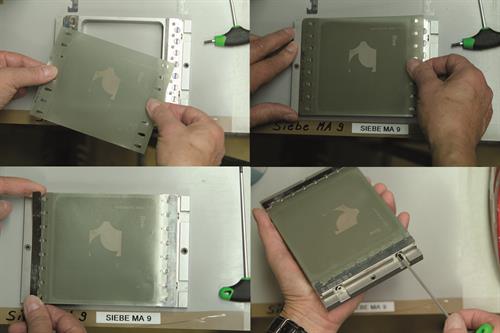A member of the Schwan-STABILO Group, Karl Meisenbach, specialises in printing writing tools, working on small-scale flat screen printing machines. In summer 2016, the company made the technological leap from analogue screen production to digital processing with the Screeny G-Line by Gallus.
Since then, Karl Meisenbach has been sourcing print-ready screen plates from Gallus in trimmed sizes industrially coated with photo emulsion. The printing plates are exposed on a Phoenix computer-to-screen system by Heidelberger Druckmaschinen AG (Heidelberg). They are then developed in an automatic washing-out unit. The dried surface of the hardened layer has a mean roughness depth (Rz value) of less than five microns.
Gallus has developed an innovative quick-action stretching frame made of light metal for inserting the screen printing plate into the printing machine. On the narrow sides, the screen printing plate is precisely fixed in place in a clamping device by means of punch holes and tensioned with a pre-defined spring force. An adhesive tape seal on the long sides of the frame prevents ink from escaping during the printing process.
Standardised procedure means production reliability
The transition from analogue to digital printing results in economic as well as production-related gains for Karl Meisenbach. Gallus now cuts the screen printing plate and coats with photo emulsion in one standardised procedure, as these are work steps which have a significant influence on the printing results. The angle of the weave and the thickness of the emulsion are precisely defined and do not vary. Karl Meisenbach also profits from a reliable process when it comes to exposure: the computer-to-screen technology builds the imaging points with precise, repeatable screen angulation.

The Screeny G-Line principle: minimal handling to mount the imaging screen printing
plates in the frame
Thanks to Screeny G-Line, a screen printing plate is ready for production in four steps: exposure, washing-out, tensioning and preparation (sealing the long sides of the screen). “Compared with the previous, mostly manual technology, up to 60 minutes can be saved per screen printing forme,” says Marco Farina, Head of Design at Karl Meisenbach. Gallus estimates overall cost savings of up to 25% per screen print.
Phoenix: CtS system with precision optics by Zeiss
An important link in the digital production chain is the new Phoenix computer-to-screen system. The imagesetter works with a UV LED light source, with radiation energy being diverted to the emulsion by means of DMD technology (Digital Micromirror Device). Precision optics by Zeiss and predictive focus control ensure that the imaging elements on the screen printing plate produce edge-sharp exposure. As Marco Farina says, Karl Meisenbach achieves “excellent printing results” by exposing on the Phoenix with a screen ruling of 60 lines per centimetre.
Phoenix is a dual exposure system. Water-cooled LED UV lamps emit UV energy at 385 and 405 nanometres. The two wavelengths are cumulated into one exposure beam. According to Heidelberg, this leads to a differentiated hardening on the surface and deep within the emulsion. As a consequence, print forme lifetimes are prolonged and highly reproducible.
 Karl Meisenbach exposes motifs on the Phoenix CtS system with a screen ruling of 60 lines per cm
Karl Meisenbach exposes motifs on the Phoenix CtS system with a screen ruling of 60 lines per cm
Screeny G-Line takes the load
According to Marco Farina, there are no downsides to Screeny G-Line and digital exposure compared with analogue procedures: “We are faster, the screen dot is sharper, and the print image is more finely detailed,” he explains. At the same time the changeover is going smoothly. While Karl Meisenbach works solely with Screeny G-Line and Phoenix for new jobs, for repeat jobs the transition is taking place one step at a time “because we need to adjust the colour formulas and printing process to achieve identical results,” says Farina. But the proportion of work shifting towards the new technology is growing. After 10 months, about 70% of Karl Meisenbach’s job load is being completed with Screeny G-Line and the Phoenix CtS system.